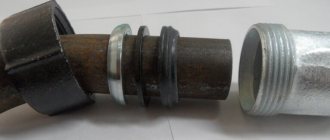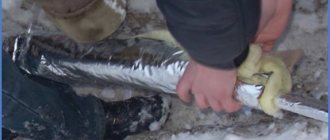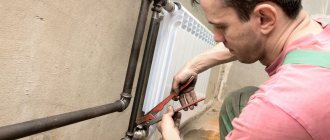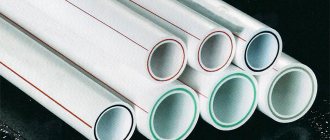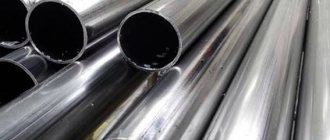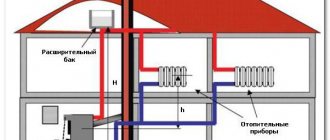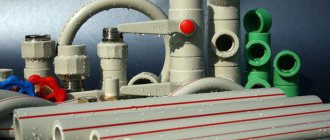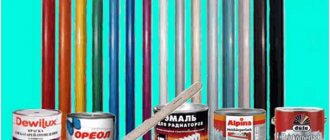Features of choosing thermal insulation for pipes
Thermal insulation is used both for centralized heating lines and intra-house heating networks in order to reduce heat loss. When choosing thermal insulation, you need to take into account the diameter of the pipes, the temperature of the coolant and operating conditions. The type of insulator that will be used depends on the diameter of the pipes. These can be hard molded cylinders, half-cylinders, and soft mats in rolls.
Insulation of heating pipes of small diameter can be done using cylinders, half-cylinders (equipped with grooves that create convenient and quick installation on the pipes), also using segments made of polymer or mineral wool heat-insulating materials. They have very high thermal resistance. In addition, they have a low degree of water absorption, resistance to mechanical damage and strict geometric dimensions. Let's consider the areas of application of the most popular materials for thermal insulation.
Secrets of proper insulation of water pipes
A warm pipe can become an attractive habitat for rodents.
To prevent them from chewing through layers of materials, you can:
- wrap the pipes with metal mesh;
- plaster with concrete mixture with broken glass;
- wear a metal sleeve.
It will be useful to draw up a diagram of the underground part of the pipeline and save it in case of repair work. It is best to insulate pipes in the summer, when the groundwater level drops and the ground is dry and warm.
Filling the ditch
Filling of the ditch begins after checking the heating system in action - if pressure testing of the circuit reveals flaws in its tightness, they will need to be removed.
Backfilling a ditch is a serious stage of work, the accuracy of which determines the uniform distribution of loads and the durability of the pipeline section in the ground.
Backfilling of the ditch begins with laying soft plastic soil on both sides of the pipe (in the grooves). This is done equally along the entire length of the pipeline, preventing it from moving to the sides. The soil laid on both sides is thoroughly compacted, after which the pipeline is backfilled from the same material with a layer of protection of at least 15 cm along the entire length and width of the ditch in accordance with the requirements of SNiP. The compaction of this layer is carried out to a small extent - this is a necessary requirement for the formation of a strong protective arch of soil over the pipe, resting mainly on the sinuses on both sides of the pipe.
After compaction of the protection layer is completed, the ditch is completely filled with soil removed during excavation, removing large stones from it. Backfilling must be done equally along the entire length of the ditch, preventing the formation of pipe sections with a significant difference in the vertical load from the soil.
The equally growing load from the backfill will be taken up mainly by the protective soil arch above the pipe, and the final value of the compression force for the pipe is not terrible - it is designed for it.
If the ditch is filled in separate sections, then the difference in the vertical load on the backfilled and open sections of the pipeline will lead to the appearance of tensile forces, which the pipe resists less well.
Underground heating installation
In some cases, it is necessary to lay heating pipes in the ground, for example, when the boiler room is some distance from the heated room. Before laying heating pipes underground, you will have to solve two problems at once:
A layer of soil and everything that is on the surface presses on a pipe laid on the ground. Therefore, in order to protect the system, sleeves are used. A PVC sewer pipe with a diameter of 110 mm is perfect for this purpose.
Before laying heating pipes underground in a sleeve, they must be insulated, despite the fact that the system is laid below the freezing level of the soil. The heat loss is still significant. For insulation, mineral wool or foam covers are used. In addition, pipes are produced that have a layer of foam insulation and a protective plastic shell. They are specifically designed for underground installation.
When organizing an individual water supply for a house with water taken from a well or borehole, it is necessary to take measures for the normal operation of the water supply system in winter to prevent freezing of the water in the pipe. Therefore, the question of how to insulate a water pipe in the ground with your own hands is relevant for all users of their own water supply line. To insulate a pressure water pipeline underground, it is necessary to calculate and select the most optimal insulation option and install it correctly in compliance with the technology.
Rice. 1 Map of soil freezing levels
Why do you need to insulate pipes?
If you look at the map of freezing depths, you can see that in the northern regions it reaches 2.4 meters - naturally, digging holes of such depth on your site is too expensive. In addition, this is irrational from the point of view of supplying water from a well or well to the house; problems will arise with the well - the pressure pipe must come out of the head and in order to install pumping equipment it will be necessary to dig out and equip a caisson or a caisson pit of very great depth. Using insulation for water pipes in the ground, you can lay a water main at a shallow depth, saving money and increasing the ease of use and maintenance of pumping equipment.
Another advantage of insulating water pipes in the ground is saving resources. The water entering the house is heated for domestic needs and heating - it is clear that heating colder water will require more electricity. If the pipes are insulated from cold soil, then the costs of insulation and work will not only be fully recouped over time, but will also bring significant savings.
An effective way to combat freezing of water pipelines is to use an electric cable, which is glued to the line along its entire length and lowered into the well. Placing the cable and pipeline as additional insulation in a warm shell will significantly save energy when heating the water main.
Rice. 2 Table of heat losses depending on the thickness of the insulator
Mineral wool
Insulating materials using mineral wool are very effective heat insulators. They are used in a wide variety of conditions. Thermal insulators made of mineral wool tolerate temperatures up to 650°C without losing their thermal insulation and mechanical properties. At the same time, they do not lose their shape and have high chemical resistance to oil, solvent, acid, and alkali. They are non-toxic, and thanks to special impregnation, they have a very low degree of moisture absorption. (See also: Water floor heating)
Advice! Mineral wool is well used to protect heating network pipelines and hot water supply pipelines in residential and public buildings, domestic premises, as well as pipelines whose surface is subject to heating, for example, chimneys.
Types of mineral wool
Stone wool is made from alloys of basalt rocks. It was described above.
Installation of a chimney for a gas boiler
Installation of a chimney for a gas boiler begins with cutting out an exhaust hole, the size of which depends on the diameter of the chimney pipe
Fiberglass
Glass wool has an average thickness of up to 3-4 microns and 1550-200 mm. Thermal insulation materials made from glass staple fiber have a low density and application temperature (up to 180°C). Such materials are recommended for use in overhead pipelines, for example, heating networks. Therefore, fiberglass is used in a more limited area. High-quality fiberglass is characterized by high vibration resistance, biological and chemical resistance, as well as a long service life. (See also: Polypropylene pipes for heating)
Egor Guest
It is more convenient to use ready-made insulation. We found polyethylene foam for 13mm pipes (this is the norm for hot water supply).
Next, we selected the finished pipe insulation so that it fits over the first thermal insulation. There can be any number of such layers.
If there is an air gap between the first and second insulation, this is good.
It is important to seal the seams of the last layer of insulation with reinforced tape
You can wrap it with roll insulation, but it’s easier to wrap it not in two layers of 5 mm, but in one layer of 1 cm.
The foil inside will not work because... she needs a gap, in my opinion, 20mm. It can be oriented outward or simply wrap the last layer with foil tape (this is done when installing air conditioners).
Insulation of heating pipes is a mandatory stage of work during the installation of the entire system. This is especially true for pipe sections located outside a residential area (for example, on the street) and most exposed to adverse weather conditions.
The insulation material serves as a protective layer that maintains a given temperature regime, prevents the formation of condensation and slows down the process of metal corrosion.
Timely insulation of heating pipes can significantly reduce the percentage of heat loss and protect the pipes from deformation in conditions of sudden changes in weather conditions.
Heat loss on the way from the boiler to the radiators can vary between 5-15%. Accordingly, in order to achieve the optimal temperature in the house, the owners have to significantly increase the boiler power and pay the costs out of their own pockets.
Insulated heating pipes allow you to forget about this problem for a long time.
In this case, the coolant circulating through the pipes cools much more slowly, does not change its temperature and does not crystallize at the lowest temperatures.
The need for thermal insulation
A master who decides to optimize a heating circuit inevitably faces two questions: why do this and how to insulate the heating pipes?
Thermal insulation of heating pipes on the street and at home is highly desirable for the following reasons:
- This measure helps to significantly reduce the loss of thermal energy when transferring coolant (usually hot water) from the place of primary heating to radiators and other devices.
- Insulation of heating pipes on the street helps prevent thawing with subsequent subsidence of the soil layer in the places where the heat supply line passes.
- Coating heating circuit elements with an insulating layer is an excellent means of preventing corrosion processes (if metal pipes are used to supply heat).
- Since, as statistics show, when transferring coolant (including water) over long distances, up to 25% of thermal energy is lost (in some cases more), timely high-quality thermal insulation of pipes can reduce heating costs.
Vertical pipeline laying
Schemes with a vertical arrangement of highways are very popular among residents of multi-storey cottages.
This is due to the peculiarities of the functioning of such schemes:
- The coolant is heated in the boiler and rises up the line. After this, it descends along all existing risers to the radiators;
- From these radiators, the coolant returns back to the boiler, while, in the case of two lines, the return movement is carried out along horizontally located elements.
It must be said that the supply branch is also located horizontally. The scheme got its name - vertical or top - for the simple reason that the coolant comes from above, which can be seen in the image below:
Consists of the following elements:
- Heating boiler;
- Circulation pump (as a rule, it is present, but it may not be);
- Expansion tank of an open or closed type (if there is a pump, then a closed-type membrane tank is used, but if there is no pump, that is, natural circulation, then the tank is used of an open type);
- Vertical and horizontal branches;
- Batteries;
- Shaped elements.
Principle of operation
The operating principle of all vertical structures is quite simple. From the heating element, the coolant flows into the expansion tank. The movement occurs along the riser.
The expansion tank should be located at the highest point. This container serves to normalize and create pressure.
Further from the tank there is a branch, which is called the supply branch, or in this case, the branch branch. This line goes to each battery. Thus, from the expansion tank, the heated coolant through this line enters the batteries.
Here it gives off its heat to the environment. At this time, the denser cold water pushes the heated water out of the boiler. This creates coolant movement. Thus, slightly cooled water from the batteries enters the return line, which leads directly back to the boiler.
Today, almost all such schemes are equipped with a circulation pump, which forces water to move through the mains. This leads to faster heat transfer, and therefore increases the efficiency of the entire structure.
The great advantage of the upper location of the branches is that their arrangement allows heating multi-story buildings.
In addition, no one forbids, as in the previous case, putting its own shut-off valve on each individual radiator. In this case, there is no need to cut in separate lines, since the design already provides for a parallel supply of coolant to all batteries.
Burying pipes
The first method of deep burying pipes is the oldest and most proven, but it cannot always provide the required level of protection. The bottom line is that the pipeline is laid just below the depth of soil freezing, which is determined by the climatic characteristics of a particular area. In the layer of earth located below the freezing level, the temperature is almost constant.
At first glance, it may seem that at minimal cost you can protect pipes from the cold, but in reality not everything is simple because it is not always possible to achieve the desired depth. There can be many good reasons for this - from the significant labor intensity of the work to the characteristics of the soil.
In some cases, even 1 meter deepening may be problematic. If you need to go even deeper, the complexity of the work will become an order of magnitude higher.
When choosing a method of insulation, do not forget about one more important point. If a sewer breaks down, even if not due to cold weather, its repair will be quite expensive, since in order to identify the defect you will have to first dig up the pipe and then bury it again
Heating pipes with electric cable
Obviously, it is possible to insulate sewer pipes by burying them to a sufficient depth only in external areas. However, there are other areas, located both on the street and in rather poorly heated rooms. For such areas, you can use a special heating electric cable laid along the most important components and connections. The result of the work performed will be constant heating, protecting the sewer system regardless of the weather.
True, this method has a couple of disadvantages. First of all, electricity consumption increases, especially in the case of heating rather long pipelines. There is also a dependence on the operation of electrical networks. Of course, if there is a power outage, the generator will start working, however, this also costs a lot of money.
Why isolate
When laying a pipe outside a building, it (and the environment flowing inside) can be adversely affected by moisture and low temperatures. In addition, some materials (polymers) deteriorate faster and lose their quality when directly exposed to sunlight.
The pipeline can also be damaged by human actions (intentional or unintentional).
It is preferable to lay pipes in the ground for the following reasons:
- To prevent the negative factors mentioned above.
- In order not to create a network of communications (which will take up space and interfere with passage/travel) on the surface.
When laying a line underground, the following dangerous factors remain relevant:
- Possibility of freezing of the liquid flowing inside.
- The possibility of corrosion of the pipe itself is due to exposure to moisture.
The first factor is relevant in winter: the depth of soil freezing in most Russian regions reaches (or exceeds) 1 meter. That is, in order to prevent the flowing medium from freezing in cold weather, the pipes should be laid in the ground deeper than this indicator.
This is often inconvenient: it complicates further maintenance of the line (if inspection or repair is necessary, you will have to dig a deep trench), and increases the cost and time of excavation work during installation.
About the danger of lack of insulation
Water supply and sewerage pipes are laid in the ground - both municipal (going from and to multi-apartment residential buildings), and for private houses and various industrial buildings. Insulation must be used in both cases - since water flows inside these lines.
Moreover, it freezes very quickly - in less than an hour an ice plug will form inside.
Since the pipeline is laid in the ground, to remove it you will have to dig a trench, look for a frozen place and warm it up. And all this - in the cold. Moreover, the sewerage or water supply will not work in the house (depending on which line “runs down”).
In addition to the troubles that the sewer or water supply in the house stops working, when an ice jam occurs, there is also the possibility that the pipe will burst. This happens because when moisture freezes, it expands, meaning ice will take up more space than water. As a result, the pipe walls may not withstand it.
Fixing this problem is an even more difficult and less pleasant task than steaming a frozen area. In winter, in the cold, you will have to not only dig a trench (and not a small one, but along the entire line of the pipe - in order to find the damaged part) - but also repair the pipe itself. Often this can only be done by completely replacing the cracked segment.
Advantages and disadvantages of foam insulation
Polystyrene foam (aka EPS, polystyrene foam, expanded polystyrene, “polystyrene” colloquially) is a popular pipe insulation, designed for maximum protection from the effects of cold and moisture. Foam insulation is easy to install, provides a high class of thermal protection, and also protects pipes from physical impact (within reasonable limits). Polystyrene foam is reliable and can withstand even constant soil impact, which allows it to be used to protect pipes laid in the soil that most need it.
In addition, polystyrene foam can also be used as an acoustic insulator, so if you are annoyed by the sound of water in the pipes, this is the only solution. It is worth noting that the foam shell is reusable, so if you need to replace the pipe or dismantle it altogether, you can always remove the shell and use it somewhere else later. Considering the maximum ease of installation, this is very important.
It is also worth noting that the shell is inexpensive, especially if the alternative is only deep laying of pipes on a concrete base. A linear meter of foam protection will cost approximately 160 rubles for a pipe with a diameter of 110 mm (standard for laying water supply/sewage systems around the house). For larger products, the price will increase exponentially - for example, a pipe with a thickness of 219 mm will cost 310 rubles, which is still more profitable than alternative options.
This insulation has no disadvantages (if high-quality foam is used and not oversaturated with styrene), so we recommend using it.
In addition to polystyrene foam, another insulation material that comes straight from Soviet times is actively used. Mineral wool is the simplest known insulation material. Just half a century ago, he ruled the market. The main problem is the complexity of installation, since the insulation is supplied only by weight and requires that it be securely secured to the pipes in some way. The classic solution is to wrap the pipe with water-repellent fabric, with cotton wool glued to the inner surface. The method is complex, unreliable and disposable, which is why mineral wool (and its variety, glass wool) has almost been pushed out of the market these days.
Mineral wool in shell is a little more popular - a recent decision, an attempt to return this material to the market in a new form. It is a shell made of solid material (usually polyurethane foam, but polystyrene foam is also found) and actually combines the advantages of polyurethane foam and the low price of mineral wool.
However, this solution is not particularly popular due to its theoretically low reliability and weak protective characteristics relative to the same foam. Perhaps one day it will be able to compete with polystyrene foam or even full-fledged polyurethane foam, but at the moment it is viewed with distrust.
Which pipes are suitable for heated floors?
Polymer pipes for laying under screed
Naturally, modern heated floors are installed from plastic, but it can be different and has different characteristics. Laying heating pipes in a private house under a screed replaces traditional radiator systems. To select a material, you need to determine the selection criteria:
The laying of heating pipes in a private house under a screed is carried out only in whole sections, without connections. Based on this, it turns out that the material must bend and the direction of coolant flow must change without the use of fittings. This characteristic does not include products made from single-layer polypropylene and polyvinyl chloride;
resistance to heat.
All polymer pipes for heating, external and hidden, can withstand heating up to 95 degrees, while the temperature of the coolant rarely exceeds 80 degrees. In a heated floor, the water heats up to a maximum of 40 degrees;
For laying heating pipes in the floor screed, only reinforced products are used, they are also called metal-plastic. Although the reinforcement layer is not only metal. Each material has a certain thermal elongation. This coefficient indicates how much the circuit lengthens when it is heated by one degree. The value is determined for a section of one meter. Reinforcement is needed in order to reduce this value;
Once the heating pipes are laid in the floor screed, there will no longer be access to them. If a leak occurs, you will have to dismantle the floor - this is a sawing and labor-intensive process. Manufacturers of polymer pipes provide a 50-year guarantee on their products.
Reinforced polymer pipes consist of five layers:
- two layers of plastic (inner and outer);
- reinforcement layer (located between the polymers);
- two layers of glue.
Thermal linear expansion is the property of a material to increase in length when heated. The coefficient is indicated in mm/m. It shows how much the contour will increase when it is heated by one degree. The coefficient value shows the amount of elongation per meter.
PEX pipe reinforced with aluminum
Immediately we should mention the types of reinforcement. It could be:
- aluminum foil (AL), thickness 0.2–0.25 mm. The layer can be solid or perforated. Perforation is the presence of holes, like in a colander;
- fiberglass fiber is thin fibers of plastic, steel, glass or basalt. The markings indicate FG, GF, FB;
- ethylene vinyl alcohol is a chemical element that changes the composition of plastic. Labeled Evon.
Before laying heating pipes in a private house, you should make sure that they have a layer of reinforcement with aluminum foil or ethylene vinyl alcohol. Since one of the requirements when choosing a material is the elasticity of the contour. Products reinforced with fiberglass fiber cannot be bent; fittings and couplings are used to change the direction of coolant flow, which is unacceptable in our case.
Let's look at the types of materials used for the production of metal-plastic pipes:
polypropylene. Such products are marked PRR/AL/PPR. Thermal linear expansion is 0.03 mm/m;
cross-linked polyethylene. It differs from conventional low-density and high-density polyethylene in that it undergoes an additional production step called cross-linking. On it, the number of bonds between molecules increases, thereby giving the product the necessary characteristics. It is marked PEX/AL/PEX and has a coefficient of thermal linear elongation of 0.024 mm/m, which is less than that of propylene.
We will separately consider products made of cross-linked polyethylene reinforced with ethylene vinyl alcohol, since it is best to lay such heating pipes in the floor. They are labeled PEX /Evon/PEX. This reinforcement method allows you to kill two birds with one stone. Firstly, it reduces the linear expansion of the material to 0.021 mm/m, and secondly, it creates a protective layer that reduces the air permeability of the pipe walls. This figure is 900 mg per 1 m2 per day.
The fact is that the presence of air in the system not only leads to cavitation processes (the appearance of noise, water hammer), but also provokes the development of aerobic bacteria. These are microorganisms that cannot exist without air. Their waste products settle on the internal walls, and so-called silting occurs, while the internal diameter of the pipe decreases. For polypropylene pipes with aluminum foil reinforcement, the air permeability of the walls is zero.
Insulation methods
There are several known ways to effectively insulate the water mains supplied to the house. Some of them are used not only in everyday life, but also in production, where pipeline insulation is no less important.
Application of thermal insulation materials
For the stated purposes, conventional insulation materials are widely used, used to solve typical problems, including insulation of building structures. These include the following types of thermal insulation materials:
- Styrofoam;
- polyurethane foam;
- mineral wool;
- sprayed insulation.
Sprayed polyurethane foam
Foiled polyurethane foam
Styrofoam
Mineral wool
Most of them allow you to reliably isolate the water supply from contact with the ground, which freezes to a considerable depth in winter.
Electric heating and continuous flow effect
An electric cable with alternating current passed through its sheath is a common method that guarantees insulation of water supply pipes in a private house. Self-heating cable products operate automatically and guarantee a minimum of energy consumption for heating. This effect is achieved due to built-in automation, thanks to which energy consumption increases only after the ground temperature drops below a certain level. Electrical cables are well protected from moisture, which allows them to be laid directly in water pipes.
The essence of heating using the continuous flow method is that fast moving water does not have time to freeze. If the house has regular water consumption or artificially organized water circulation in a closed circuit, they will prevent the pipeline from freezing in the winter.
Heating with air and increased pressure
This method is technically difficult to implement and is used only in public utilities or in industry. The water supply is placed in a shell of large-diameter pipes, and heated air enters the gap between them. In everyday life, a simplified scheme is used, in which HDPE pipes are insulated by placing them in pipelines of larger diameter. The air gap formed between them is used as a kind of insulator.
The idea of high pressure heating is more of a fantasy than a reality. To increase the temperature by 1 degree, it will be necessary to increase the pressure by 132 atmospheres, which is physically impossible for a water supply with an indicator of 5 atm.
Factors affecting heating pipes in the ground
A heating pipe buried in the soil is subject to the same influences as an external pipeline, plus factors caused by deepening:
- internal pressure of the coolant, causing circumferential and elongated tensile stresses in the pipe section;
- temperature of the coolant is a factor, in addition to thermal influence, also causing pipeline stress;
- soil temperature - in winter, taking this into account is very important;
- soil deformations - the pipe is affected by any of its displacements (settlement, shear, etc.);
- pre-bending stress of the pipeline - the ditch profile often follows the local terrain;
- vertical load - the influence of the weight of the ditch backfill layer;
- the resistive action of the soil on the walls and bottom of the pipeline - resistance to vertical load;
- vibration loads - from passing vehicles, excavation work in the neighborhood, etc.;
- moisture – precipitation and groundwater;
- the influence of chemical substances - compounds in the soil and heat carrier;
- biological factor - bacteria, decomposition.
Likewise, laying a pipeline in the soil should be carried out taking into account all the factors listed above and solving the problem of how to make heating pipes in the ground warmer.
Price
Prices for insulation for underground water pipes are based on diameters and thickness.
Approximate cost per linear meter:
- Basalt cylinder – 33-220 rub.
- Expanded polystyrene. A meter of polystyrene foam shell will cost 120-700 rubles.
- Foamed polyethylene (Energoflex, Thermoflex, etc.) - from 10 to 500 rubles.
Glass wool is sold in rolls. Price for 1 m2 is approximately 100-130 rubles.
A meter of Folgizol waterproofing costs about 25 rubles.
The heating cable is sold in a package, from 2 meters (the longer, the cheaper):
- Constant power from 95 to 714 rubles.
- Self-regulating – 500-1660 rub.
An emergency with a water supply can happen due to a small leak, so along with high-quality insulation, all seams and pipe joints must be done conscientiously. Changing the system in winter is extremely problematic. To avoid having to sit without water while waiting for spring, it is better to immediately apply effort and resources and insulate the pipeline according to all the rules.
Not everyone decides to install a water-heated floor in their home, because this is associated with considerable inconvenience, especially due to the need to install a concrete screed. This takes time, and the work itself is dirty. However, not everyone knows that there is a good alternative - polystyrene foam for heated floors. Let's look at the main characteristics and styling features.
Read about the rules for installing stove heating with a water circuit in this topic.
Trenchless methods of pipeline laying
There are technologies for laying a pipeline in the ground without making trenches.
Such methods are aimed at:
- reduce the volume of excavation work - saving time and costs;
- minimize damage to infrastructure - less costs for restoration of decorative and road surfaces, unexpected damage to highways;
- lay pipes in a straight line, without going around obstacles of low complexity;
- minimize damage from excavation work to the environment.
Today, the following trenchless methods are used in industry:
- rehabilitation;
- piercing
Sanitation
- This is the replacement of old pipes with new ones, which, in turn, is done in two ways: relining and the renovation method.
Relining
is based on drawing a new polymer pipe of smaller diameter inside the working pipeline while preserving the old one as a protective shell.
Renovation
– installation of a new pipe to replace the old one, worn out and destroyed, the fragments of which will also protect the new main from external damage.
Piercing (pushing)
- this is the connection of two pits dug to the required depth by a puncture made at a certain height of the wall.
Of the listed methods, we will perform only the relining method in everyday life. A cable is inserted into one end of the old pipe and pushed until it comes out of the other end. Then a new lash is attached to the cable and pulled back. The possibility of using this method depends on a number of factors:
- the condition of the lumen of the old pipeline;
- diameter of the new pipe;
- flexibility of the new whip;
- length of the repaired area;
- ratio of the diameters of the old and new pipeline.
With a favorable combination of the listed factors, the technical execution of installing a new pipe is not difficult. However, all this applies to drawing a new line without thermal insulation, and the condition of the insulation of the old pipe is unlikely to be satisfactory. Since it is not possible to insulate heating pipes inside an old line, the method loses its attractiveness when applied to heating.
Therefore, when installing heating pipelines buried in the ground in private housing, digging a trench or, at a minimum, alternatively laying the pipe on the ground with backfill is indispensable.
Today, according to their design, all heating systems can be divided into many types and types - the classification is very diverse and has many parameters. Among others, the type of wiring is also distinguished.
The layout can be horizontal or vertical. Depending on the chosen type of installation, the composition of the heating circuit may change, but more about everything below.
Do-it-yourself insulation of a water pipe
The easiest way is to use special insulating shells.
Before insulating underground water pipes, you need to decide which thermal insulation option will be the cheapest. Most often they stop at using inexpensive foam or PPS shells with a high density of material.
Insulation at shallow depths
The procedure for insulating a water supply system in a country house or in a private house is considered using the example of a foam plastic shell. Self-installation of the shell on a HDPE pipeline is not difficult and is carried out in the following sequence:
- The foam shell itself is put on the pipes slightly raised from the trench.
- The locks on it snap into place, each next segment moves by about a third of the total length.
- The insulating elements are fixed with tape or special plastic ties.
- At the end of the work, the pipeline is lowered into a trench onto an already prepared sand bed.
At the final stage of the activity, the trench is filled with the selected soil and then covered with turf set aside.
Circuits with bottom wiring
As already mentioned, pipe laying can be done in two ways - vertically or horizontally. In the first case, such wiring is called upper, and in the second - lower. Both can be used for the device. There are restrictions only for multi-storey buildings. Often the second floor heating system consists only of underfloor heating.
So, all heating systems of a private house with bottom wiring can be of two types:
- Single-pipe, that is, they contain only a supply pipeline, which is also a return pipeline;
- Two-pipe - with separate supply and return lines.
